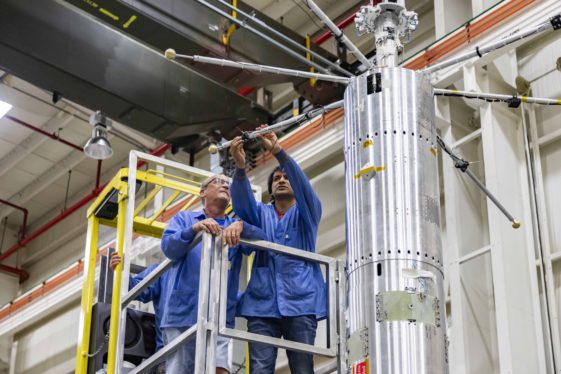5 min read
To Study Atmosphere, NASA Rockets Will Fly into Oct. Eclipse’s Shadow
On Oct. 14, 2023, viewers of an annular solar eclipse in the Americas will experience the Sun dimming to 10% its normal brightness, leaving only a bright “ring of fire” of sunlight as the Moon eclipses the Sun. Those in the vicinity of the White Sands Missile Range in New Mexico, however, might also notice sudden bright streaks across the sky: trails of scientific rockets, hurtling toward the eclipse’s shadow.
A NASA sounding rocket mission will launch three rockets to study how the sudden drop in sunlight affects our upper atmosphere. The mission, known as Atmospheric Perturbations around the Eclipse Path or APEP, is led by Aroh Barjatya, a professor of engineering physics at Embry-Riddle Aeronautical University in Daytona Beach, Florida, where he directs the Space and Atmospheric Instrumentation Lab.
Some 50 miles up and beyond, the air itself becomes electric. Scientists call this atmospheric layer the ionosphere because it is where the UV component of sunlight can pry electrons away from atoms to form a sea of high-flying ions and electrons. The Sun’s constant energy keeps these mutually attracted particles separated throughout the day. But as the Sun dips below the horizon, many recombine into neutral atoms for the night, only to part ways again at sunrise.
During a solar eclipse, the sunlight vanishes and reappears over a small part of the landscape almost at once. In a flash, ionospheric temperature and density drop, then rise again, sending waves rippling through the ionosphere.
“If you think of the ionosphere as a pond with some gentle ripples on it, the eclipse is like a motorboat that suddenly rips through the water,” Barjatya said. “It creates a wake immediately underneath and behind it, and then the water level momentarily goes up as it rushes back in.”

During the 2017 total solar eclipse visible across North America, instruments many hundreds of miles outside the eclipse’s path detected atmospheric changes. So did critical infrastructure like GPS and communications satellites that we rely on every day.
“All satellite communications go through the ionosphere before they reach Earth,” Barjatya said. “As we become more dependent on space-based assets, we need to understand and model all perturbations in the ionosphere.”



To this end, Barjatya designed the APEP mission, choosing the acronym because it is also the name of the serpent deity from ancient Egyptian mythology, nemesis of the Sun deity Ra. It was said that Apep pursued Ra and every so often nearly consumed him, resulting in an eclipse.
The APEP team plans to launch three rockets in succession – one about 35 minutes before local peak eclipse, one during peak eclipse, and one 35 minutes after. They will fly just outside the path of annularity, where the Moon passes directly in front of the Sun. Each rocket will deploy four small scientific instruments that will measure changes in electric and magnetic fields, density, and temperature. If they are successful, these will be the first simultaneous measurements taken from multiple locations in the ionosphere during a solar eclipse.
Barjatya chose sounding rockets to answer the team’s science questions because they can pinpoint and measure specific regions of space with high fidelity. They can also measure changes that happen at different altitudes as the suborbital rocket ascends and falls back to Earth. The APEP rockets will take measurements between 45 and 200 miles (70 to 325 kilometers) above the ground along their trajectory.
“Rockets are the best way to look at the vertical dimension at the smallest possible spatial scales,” said Barjatya. “They can wait to launch at just the right moment and explore the lower altitudes where satellites can’t fly.”
While the in-situ rocket instruments are all being built by Embry-Riddle and Dartmouth College in New Hampshire, a host of ground-based observations will also support the mission. Co-investigators from the Air Force Research Laboratory at Kirtland Air Force Base in Albuquerque, New Mexico, will collect ionospheric density and neutral wind measurements. Co-investigators from the Massachusetts Institute of Technology’s Haystack Observatory in Westford, Massachusetts, will run their radar to measure ionospheric perturbations farther away from the eclipse path. Finally, a team of students from Embry-Riddle will deploy high-altitude balloons (reaching 100,000 feet) every 20 minutes to measure weather changes as the eclipse passes by. All of these measurements will aid ionosphere modeling efforts led by scientists at the University of Colorado Boulder and Embry-Riddle.
This won’t be the only APEP launch. The APEP rockets launched in New Mexico will be recovered and then relaunched from NASA’s Wallops Flight Facility in Virginia, on April 8, 2024, when a total solar eclipse will cross the U.S. from Texas to Maine. The April launches are farther from the eclipse path than for the October annular eclipse, but will present an opportunity to measure just how widespread the effects of an eclipse are.

After these two eclipses, the next total solar eclipse over the contiguous U.S. is not until 2044, and the next annular eclipse is not until 2046. “We have to make hay while the Sun shines … or, I suppose for eclipse science, while it doesn’t,” Barjatya joked. “In all seriousness though, this data set will reveal the widespread effects that eclipses have on the ionosphere at the smallest spatial scales.”
About the Author
Miles Hatfield











